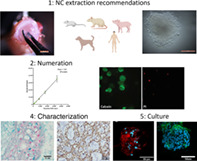- Record: found
- Abstract: found
- Article: found
Recommendations for intervertebral disc notochordal cell investigation: From isolation to characterization

Read this article at
Abstract
Background
Lineage‐tracing experiments have established that the central region of the mature intervertebral disc, the nucleus pulposus (NP), develops from the embryonic structure called “the notochord”. However, changes in the cells derived from the notochord which form the NP (i.e., notochordal cells [NCs]), in terms of their phenotype and functional identity from early developmental stages to skeletal maturation are less understood. These key issues require further investigation to better comprehend the role of NCs in homeostasis and degeneration as well as their potential for regeneration. Progress in utilizing NCs is currently hampered due to poor consistency and lack of consensus methodology for in vitro NC extraction, manipulation, and characterization.
Methods
Here, an international group has come together to provide key recommendations and methodologies for NC isolation within key species, numeration, in vitro manipulation and culture, and characterization.
Abstract
To date, there is a lack of consensus for the extraction, numeration, in vitro culture, and characterization of intervertebral disc notochordal cells (NCs). With large variations in methodological approaches affecting progress in this field. Thus, this article aims to provide key recommendations and methodologies for NC isolation, numeration, in vitro manipulation, and characterization to support research into NC physiology and potential in regenerative therapies.
Related collections
Most cited references137
- Record: found
- Abstract: found
- Article: not found
Passaging and colony expansion of human pluripotent stem cells by enzyme-free dissociation in chemically defined culture conditions.
- Record: found
- Abstract: found
- Article: not found
